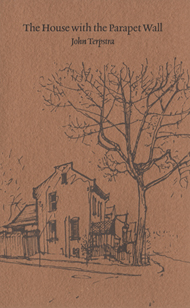Reviews
Nonfiction Review by Christin Geall
John Terpstra, The House with the Parapet Wall (Kentville: Gaspereau, 2014). Paperbound, 158 pp., $24.95.
 Do writers make the best readers? Or the most exacting? Reading Terpstra’s book, I wished I could have shut off my left brain to favour my right—to slow my analysis, absorb the work, and not dismantle the design of the book as a whole. But like the title suggests, The House with the Parapet Wall is about architecture and one can’t help notice its structure, how it is crafted of countless parts, parts that are constantly reframed and reprised.
Do writers make the best readers? Or the most exacting? Reading Terpstra’s book, I wished I could have shut off my left brain to favour my right—to slow my analysis, absorb the work, and not dismantle the design of the book as a whole. But like the title suggests, The House with the Parapet Wall is about architecture and one can’t help notice its structure, how it is crafted of countless parts, parts that are constantly reframed and reprised.
A work of creative nonfiction, the book is divided into five chapters, each containing a segmented essay, or a collection of micro-essays. Thirty-seven sections make up one chapter; fifty another. Shingled, layered, the pieces set up into a pattern of exposition/scene/reflection, the central subjects returned to throughout the book: the author’s mother’s diminishment and death; her life in Canada and the Netherlands; the author’s change of residence, and the architectural history of his neighbourhood in Hamilton, Ontario. Beyond architecture and geography—the places and spaces that fill Terpstra’s work—lies the emotional themes of grief and change, the ways in which identity is both constructed and eroded by time. He writes: “When you know what’s been lost: inlet, palace, brick mansion, memory, competence, parent…What strikes you?” Such rhetorical questions drive Terpstra’s inquiry, as he tries to make sense of his mother’s relocation to a nursing home while coming to terms with a move of his own during the shifting landscape of middle age. He answers his question simply: “What strikes me is people’s capacity to move and move on, to be moved.” Relocation and provocation run throughout the book.
Terpstra is a poet and cabinetmaker, and has done restoration work on old homes. His technical knowledge is real, his prose illuminative. One gets the sense he likes pulling things apart, peeling back layers, digging up mysteries, before putting things back together, assembling beautiful truths. He wanders his neighbourhood in his imagination, telling a story of a woman who lived a hundred years before; he traces the history of his home’s previous inhabitants; he travels to Europe to tease apart the skeins of his mother’s life; he deconstructs chimneys, pries open lath and plaster walls, becomes intimate with bricks. He works physically and poetically to uncover his relationship to the concept of home.
Early in the book he lets the reader in on his intent: “I will try to build my way up and out of this hole, brick by brick, the course-upon-course lines of words coming from above rather than from below, defying gravity.” Despite Terpstra’s allusion to transformation, this isn’t a personal memoir told along a tidy arc of epiphany. It’s a digressive work that relies upon gaps to emphasize that which we may never know: how we fall in love with a place; feel at home; leave that which we love. The author’s esoteric striving (Terpstra’s prose is too muscular to be meditative) gives the book an exploratory quality that is acutely essayistic, occasionally obtuse, but also keenly rational. He avoids sentimentality when he writes: “The wall will outlast your grief, as it has already outlasted nineteenth and twentieth century grief: barring earthquakes or war, or social upheaval, in which case all bets are off. But go ahead, wail.”
Such clarity and rigour at the level of the sentence required this book be structured as it is—set in short pithy sections so the reader might take a breath between hard-hitting lines. The only trouble with this method of book construction is that it gives the reader too many chances to deke out. Pauses become preemptory; we anticipate a subject change, and in that two-second break there’s an opportunity to skim ahead, seek out the next segment of story, flip a page, or even worse, skip out of the work. The House with the Parapet Wall isn’t an easy book to read, but it is an easy book to admire. Balancing research, narrative, and reflection, Terpstra is a highly skilled craftsman of contemporary nonfiction.
—Christin Geall









